Showing Spotlights 97 - 104 of 154 in category All (newest first):
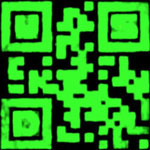 Quick Response Codes, or QR codes for short, are two-dimensional matrix codes that can hold 100 times more data than a traditional barcode. QR codes have rapidly gained popularity and are now very commonly used in various products, because of fast readability and large storage capacity. Applying the concept of QR codes to security printing applications - think banknotes - researchers have now developed an invisible QR code made from nanoparticles. They applied upconverting inks to print QR codes on paper and transparent tape, using an aerosol jet direct writing machine. They produced QR codes with embedded security characters using blue and green upconverting inks. These codes are invisible to the naked eye but produce single- and multi-color upconversion luminescence images under near-infrared excitation which can be read and decoded with an unmodified smart phone.
Quick Response Codes, or QR codes for short, are two-dimensional matrix codes that can hold 100 times more data than a traditional barcode. QR codes have rapidly gained popularity and are now very commonly used in various products, because of fast readability and large storage capacity. Applying the concept of QR codes to security printing applications - think banknotes - researchers have now developed an invisible QR code made from nanoparticles. They applied upconverting inks to print QR codes on paper and transparent tape, using an aerosol jet direct writing machine. They produced QR codes with embedded security characters using blue and green upconverting inks. These codes are invisible to the naked eye but produce single- and multi-color upconversion luminescence images under near-infrared excitation which can be read and decoded with an unmodified smart phone.
Oct 8th, 2012
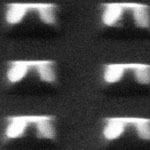 Reducing the size of photonic and electronic elements is critical for ultra-fast data processing and ultra-dense information storage. The miniaturization of a key, workhorse optical instrument - the laser - is no exception. Coherent light sources at the nanometer scale are important not only for exploring phenomena in small dimensions but also for realizing optical devices with sizes that can beat the diffraction limit of light. Researchers at Northwestern University have now found a way to manufacture single laser devices that are the size of a virus particle and that operate at room temperature. They show that subdiffraction nanoresonators based on metallic bowties, when coupled to a gain material, can generate coherent and directional light emission.
Reducing the size of photonic and electronic elements is critical for ultra-fast data processing and ultra-dense information storage. The miniaturization of a key, workhorse optical instrument - the laser - is no exception. Coherent light sources at the nanometer scale are important not only for exploring phenomena in small dimensions but also for realizing optical devices with sizes that can beat the diffraction limit of light. Researchers at Northwestern University have now found a way to manufacture single laser devices that are the size of a virus particle and that operate at room temperature. They show that subdiffraction nanoresonators based on metallic bowties, when coupled to a gain material, can generate coherent and directional light emission.
Oct 4th, 2012
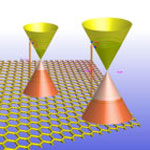 The unique energy band structure in graphene allows it to actively respond to photons with ultra-wide spectrum range - from the visible to the infrared - with record strong inter-band transition efficiency. As a consequence, graphene based ultra-fast photonics has been rising fast in various aspects of ultra-fast photonics - an ultra-fast graphene photo-detector with bandwidth exceeding 500 GHz; a broadband graphene optical modulator; a broadband graphene polarizer etc, which all benefit from the material's broadband photonics property. Researchers have now experimentally demonstrated for the first time that graphene, besides its well-known optical saturable absorption, also shows microwave and terahertz saturable absorption. The results lead to the expectation that graphene may show potential applications in microwave photonics.
The unique energy band structure in graphene allows it to actively respond to photons with ultra-wide spectrum range - from the visible to the infrared - with record strong inter-band transition efficiency. As a consequence, graphene based ultra-fast photonics has been rising fast in various aspects of ultra-fast photonics - an ultra-fast graphene photo-detector with bandwidth exceeding 500 GHz; a broadband graphene optical modulator; a broadband graphene polarizer etc, which all benefit from the material's broadband photonics property. Researchers have now experimentally demonstrated for the first time that graphene, besides its well-known optical saturable absorption, also shows microwave and terahertz saturable absorption. The results lead to the expectation that graphene may show potential applications in microwave photonics.
Oct 2nd, 2012
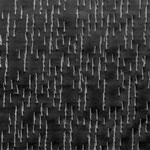 The size of pixels is one of the key limiting features in the state of the art of holographic displays systems. Holography is a technique that enables a light field to be recorded and later reconstructed when the original light field is no longer present, due to the absence of the original objects. The resolution and field of view in these holographic systems are dictated by the size of the pixel, i.e. the smallest light scattering element. To address the limitations of current holographic systems due to their pixel size, a research team set out to use nanostructures as the smallest possible light-scattering elements for producing holograms. They harnessed the extraordinary conductive and light scattering abilities of nanotubes and patterned an array of carbon nanotubes to produce a high resolution hologram.
The size of pixels is one of the key limiting features in the state of the art of holographic displays systems. Holography is a technique that enables a light field to be recorded and later reconstructed when the original light field is no longer present, due to the absence of the original objects. The resolution and field of view in these holographic systems are dictated by the size of the pixel, i.e. the smallest light scattering element. To address the limitations of current holographic systems due to their pixel size, a research team set out to use nanostructures as the smallest possible light-scattering elements for producing holograms. They harnessed the extraordinary conductive and light scattering abilities of nanotubes and patterned an array of carbon nanotubes to produce a high resolution hologram.
Oct 1st, 2012
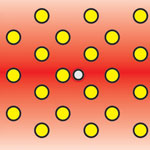 Smart phones, tablets and other electronic gadgets have become an integral part of our daily life. To maintain the steady development to even faster and smaller devices, it is desirable to replace their slow electrical data interconnects with fast optical connections. Photonic crystals are an ideal tool for such a purpose as they can guide and bend light on a nanometer scale. Surprisingly, researchers have so far been unable to truly probe inside these crystals how the light intensity is distributed - this, however, is a requirement for being able to accurately characterize the local density of electromagnetic states inside the crystal which is the key for controlling the interaction of light with matter. Researchers have now demonstrated a new concept to measure the intensity distribution of light inside photonic crystals. This method, for the first time, allows researchers to map the absolute strength of an electromagnetic field component inside a photonic crystal.
Smart phones, tablets and other electronic gadgets have become an integral part of our daily life. To maintain the steady development to even faster and smaller devices, it is desirable to replace their slow electrical data interconnects with fast optical connections. Photonic crystals are an ideal tool for such a purpose as they can guide and bend light on a nanometer scale. Surprisingly, researchers have so far been unable to truly probe inside these crystals how the light intensity is distributed - this, however, is a requirement for being able to accurately characterize the local density of electromagnetic states inside the crystal which is the key for controlling the interaction of light with matter. Researchers have now demonstrated a new concept to measure the intensity distribution of light inside photonic crystals. This method, for the first time, allows researchers to map the absolute strength of an electromagnetic field component inside a photonic crystal.
Sep 25th, 2012
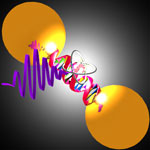 The emission of light by a single molecule is a cornerstone of nano-optics that will enable applications in quantum information processing or single-molecule spectroscopy. However, a key challenge in nano-optics is to bring light to and collect light from nano-scale systems. In conventional electronics, the interconnect between locally stored and radiated signals, for example radio broadcasts or mobile phone transmissions, is formed by antennas. For an antenna to work at the wavelength of light it is necessary to downscale the structure by the same factor as the wavelength or the frequency of the wave, i.e. roughly by a factor of 10 million. Once the nanofabrication issues are sorted out, nano-optical antennas could become ubiquitous in all applications based on light-matter interactions such as sensing, light emission (e.g. LEDs) and detection, as well as light harvesting, i.e. for solar cell applications.
The emission of light by a single molecule is a cornerstone of nano-optics that will enable applications in quantum information processing or single-molecule spectroscopy. However, a key challenge in nano-optics is to bring light to and collect light from nano-scale systems. In conventional electronics, the interconnect between locally stored and radiated signals, for example radio broadcasts or mobile phone transmissions, is formed by antennas. For an antenna to work at the wavelength of light it is necessary to downscale the structure by the same factor as the wavelength or the frequency of the wave, i.e. roughly by a factor of 10 million. Once the nanofabrication issues are sorted out, nano-optical antennas could become ubiquitous in all applications based on light-matter interactions such as sensing, light emission (e.g. LEDs) and detection, as well as light harvesting, i.e. for solar cell applications.
Jul 31st, 2012
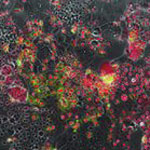 Researchers in Israel have found a unique way to affect cancer cells in a rather controllable manner. For example, they can kill these cells in various ways, or they can make them fuse together, as they like. They do so by using functionalized, 20 nm in diameter gold nanospheres and specific, intense laser pulses with a visible wavelength tuned to the plasmonic resonance of those particles. This technique may have an impact on various technologies which require sophisticated cell manipulation for therapeutic and drug development applications. What is unique about this technique is that it is highly controllable and repeatable. The structural stability of the nanospheres even after the strongest laser illumination allows them to deliver the effect over and over again, until the desired result is obtained.
Researchers in Israel have found a unique way to affect cancer cells in a rather controllable manner. For example, they can kill these cells in various ways, or they can make them fuse together, as they like. They do so by using functionalized, 20 nm in diameter gold nanospheres and specific, intense laser pulses with a visible wavelength tuned to the plasmonic resonance of those particles. This technique may have an impact on various technologies which require sophisticated cell manipulation for therapeutic and drug development applications. What is unique about this technique is that it is highly controllable and repeatable. The structural stability of the nanospheres even after the strongest laser illumination allows them to deliver the effect over and over again, until the desired result is obtained.
Jun 15th, 2012
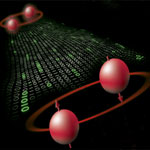 An international group of researchers reported a new record long distance for quantum teleportation. The authors claim a free-space distance of 143 kilometers. Quantum teleportation communicates physical information soundly without traveling directly through the space connecting the communicating parties. The reporting team includes quantum teleportation pioneer Anton Zeilinger of the Quantum Optics, Quantum Nanophysics, Quantum Information at the University of Vienna. Quantum teleportation combines classical and quantum information channels to transmit the complex state of quantum particles. The communication method conveys complete quantum information without the need to pass directly through the space between communicating parties.
An international group of researchers reported a new record long distance for quantum teleportation. The authors claim a free-space distance of 143 kilometers. Quantum teleportation communicates physical information soundly without traveling directly through the space connecting the communicating parties. The reporting team includes quantum teleportation pioneer Anton Zeilinger of the Quantum Optics, Quantum Nanophysics, Quantum Information at the University of Vienna. Quantum teleportation combines classical and quantum information channels to transmit the complex state of quantum particles. The communication method conveys complete quantum information without the need to pass directly through the space between communicating parties.
Jun 4th, 2012
 Quick Response Codes, or QR codes for short, are two-dimensional matrix codes that can hold 100 times more data than a traditional barcode. QR codes have rapidly gained popularity and are now very commonly used in various products, because of fast readability and large storage capacity. Applying the concept of QR codes to security printing applications - think banknotes - researchers have now developed an invisible QR code made from nanoparticles. They applied upconverting inks to print QR codes on paper and transparent tape, using an aerosol jet direct writing machine. They produced QR codes with embedded security characters using blue and green upconverting inks. These codes are invisible to the naked eye but produce single- and multi-color upconversion luminescence images under near-infrared excitation which can be read and decoded with an unmodified smart phone.
Quick Response Codes, or QR codes for short, are two-dimensional matrix codes that can hold 100 times more data than a traditional barcode. QR codes have rapidly gained popularity and are now very commonly used in various products, because of fast readability and large storage capacity. Applying the concept of QR codes to security printing applications - think banknotes - researchers have now developed an invisible QR code made from nanoparticles. They applied upconverting inks to print QR codes on paper and transparent tape, using an aerosol jet direct writing machine. They produced QR codes with embedded security characters using blue and green upconverting inks. These codes are invisible to the naked eye but produce single- and multi-color upconversion luminescence images under near-infrared excitation which can be read and decoded with an unmodified smart phone. 
 Subscribe to our Nanotechnology Spotlight feed
Subscribe to our Nanotechnology Spotlight feed





